I like straight edges on my swatches, but I’m also too lazy to pull out the blocking wires for something that is under ten inches long. Needles just don’t do it.
My solution?
Block with a spare set of double points. Works just fine.
When Michael and I adopted Peake and Watson, I was hoping that two cats might give me an edge. You see, I have this terrible problem. Cats love Michael. Doesn’t matter where we are, strays will try to follow him home, cats that aren’t friendly even to their owners will love Michael. We’ll go to a friend’s house, and by the end of the night, if that person has a cat, the cat will be camped out on Michael’s lap.
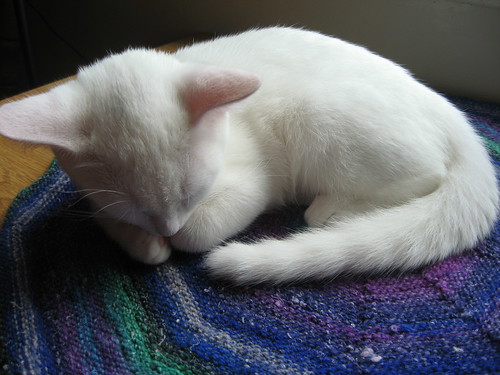 |
| Watson sleeping |
It’s problematic for two reasons. I have to compete with the cat for Michael’s affections *grins* AND I don’t stand a chance of a cat liking me more than Michael. I was hoping that if we had two cats, I’d increase my chances of one of them liking me at least as much as Michael.
If I have any hope of that happening, it rests with Watson. Watson shows all signs of mellowing out into a cuddle cat. While he isn’t there yet (he’s still a kitten, though less so than in this picture) he will be the one to leap into my lap when I’m working at my desk and snuggling with me.
The other day, I was talking to a customer about a pattern from a magazine. She had come across a line that was particularly confusing in one part of the pattern, and had come into The Yarn Spot seeking help. We puzzled over it for a couple of minutes and managed to get the pattern sorted out.
“I wish she had explained it better. You would think that a designer would have more pride in their work,” I remember her saying.
At the time I let the comment stand, because I could understand her frustration. But as a designer, I felt it would be interesting to talk about patterns and their relationship with designers. The design process encompasses much more than just the pattern in the magazine. It is entirely possible that the designer explained the pattern better in their original draft, but because of space constraints a magazine editor revised it to be shorter, sacrificing clarity.
Over the next few weeks I’ll be writing about the different aspects of what happens during the design process, and why a pattern might not be as perfect as a designer wanted it to be. I’ll be discussing the design process by further breaking it down into 5 key phases (though they don’t always come in this order): the concept, the sample, the pattern, photography, and layout.
Let’s start with The concept.
Approximately 4-9 months before a magazine, booklet, book, or single pattern is scheduled to be published, the publisher sends out a design call.
Depending on the company and the medium, a design call can be many different things. For a magazine, the editors might have a specific theme in mind for that issue of the magazine. For example, Interweave Knits might be doing a spring issue, and they want transitional pieces, pieces that move from winter to spring. A yarn company might publish booklets to go with their yarn. Classic Elite Yarn might want something that highlights their Classic Silk yarn. Someone might want to publish a book all on designs inspired by Sherlock Holmes. Once a publisher decides on the details of their theme, they put out a press release (most commonly via e-mail or on their website {like here, here or here) talking about the types of designs they want.
 |
| Drawing of Idea |
Designers are constantly keeping track of these different design calls. Not all design calls fit all designers, so most pick and choose which ones they want to work on, and which ones they have the most likely-hood of getting into.
| Swatch |
Then, designers dream. They draw pictures, create swatches, do math and layout schematics. Finally they come up with an idea that they think it will work. They put together everything they have done – the drawing, swatches, schematics and submit it to the company.
Designers then wait, work on other projects they have under contract and plan other ideas for design calls. If their proposal is what the editors are looking for, they are notified with an offer to publish their design. A contract with the publisher is signed, and the publisher (most often) sends them the yarn to create the sample.
But that’s another post.
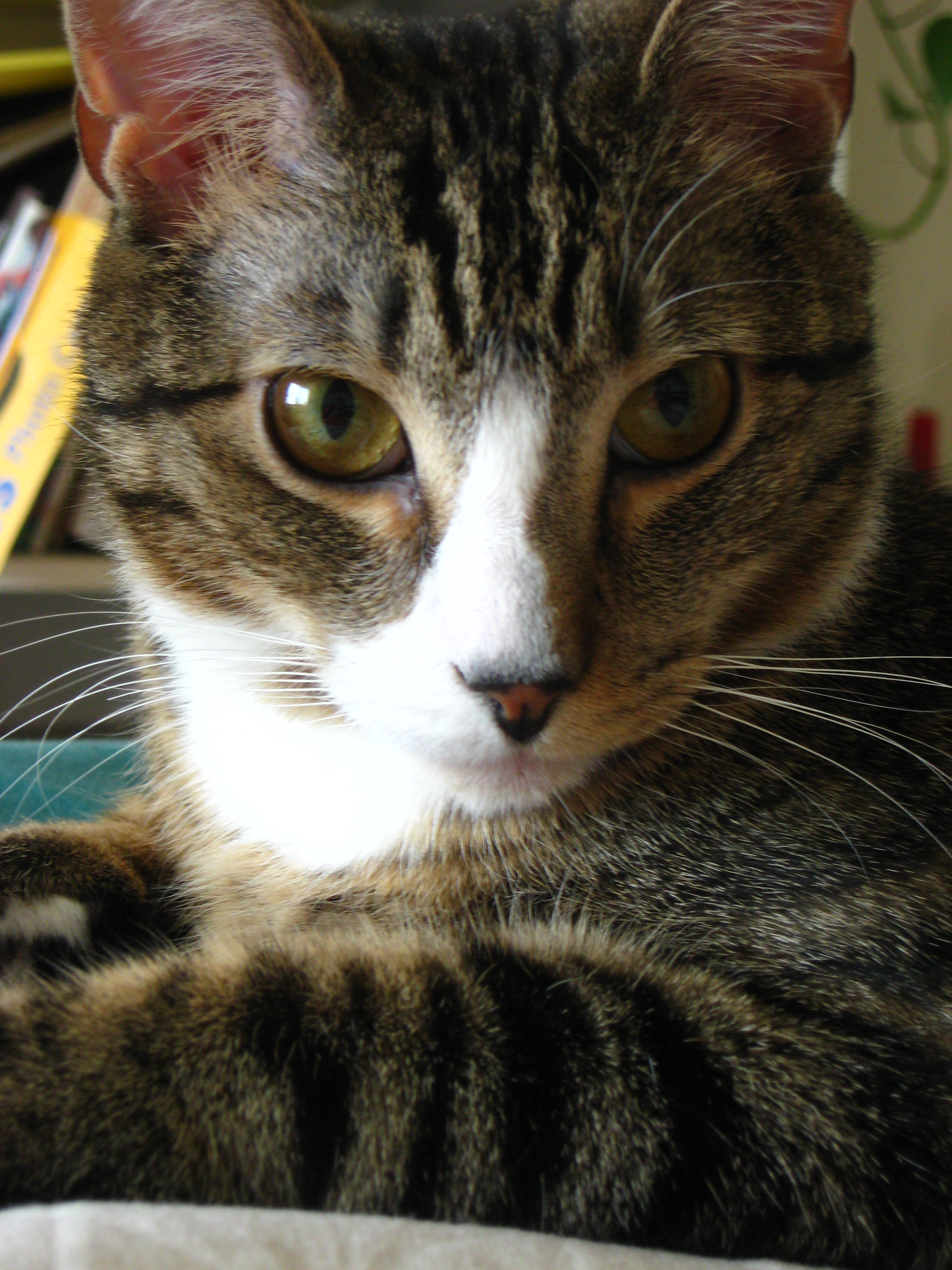 |
| Zephyr |
You might have noticed a while ago that I let the feline friday feature fade from the blog. There were several reasons for this – Zephyr, our room mate’s cat, became very sick after Michael and I moved from our room mate’s apartment. A few months later, he died, and I found it hard to post pictures of him after he had gone.
However, a few months ago Michael and I decided it was time to adopt a cat of our own in our new apartment. *grins* In the course of a weekend it turned from one cat to two, and shortly afterwards we found a family that had adopted two kittens only to find that their children were allergic.
I’ve now accumulated enough pictures of our two cats that I feel comfortable re-opening this feature.
Let me introduce you to Watson and Peake. Peake is named after the C&O’s famous Chessie‘s husband, Peake (I’ll talk about the history of that more another time). Michael’s family has a (formerly) grey tabby named Chessie (she darkened with age, and is now a black cat). It felt appropriate to name our grey tabby Peake. Also, Zephyr is the name of a rail line in Califorina (the California Zephyr), so it was nice to stick with the theme in honor of Zephyr.
Watson is white, and his name has less meaning behind it – Michael and I have a list (of course we do) of good cat names. Watson was the one that seemed to fit. Watson isn’t really entirely white – he has the smallest smudge of black/brown on his forehead. It looks like he got a bit of soot there, and he hasn’t groomed it away yet.
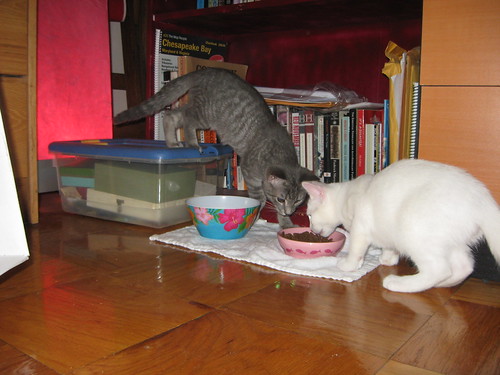 |
| Peake and Watson |
It seems that apple picking, apple butter, apple sauce, and canning are in the air. In my blog reader alone I had sever people telling of their weekend orchard adventures. But most eerie was Laura Nelkin talking about making apple butter just as I came back from stirring my own in the crockpot.
Our recipes are a little different, but the idea is the same – taking the fruits of the harvest and preserving them for the year to come.
My family lives in the Hudson Valley area of New York, and before that, we came from Massachusetts, where when I went to school, learning about Johnny Appleseed was part of the preschool, 1st and 2nd grade curriculum (it might have also had something to do with the fact that he was born in Leominster, MA, where I lived when I was young). Apple picking is nearly a cultural thing in both those parts. On apple picking days the four of us children would eat a light breakfast (As my mother knew we’d be eating apples in the orchard until we were practically sick) and then go picking. In a good orchard picking wouldn’t take very long, so then we’d go run in the maize maze, eat cider doughnuts and become awful hellions. The ride home would be sticky-faced children that had subsided into an exhausted post-applepicking haze.
Those types of memories stay with you, and when I found out Michael had never went apple picking it was clear that had to change. He had to be educated – seeing as he thought apples were “okay” and he’d really only had red delicious and granny smith (both of which are really not representative of the best of apples).
We now go picking each year.
Last year we went picking and accidentally got just over 100 lbs of apples. We were processing for DAYS.
This year we were much more reasonable – 50 lbs for canning, 10 lbs for eating. It’s going to be a fun next few days.
Our Apple Butter Recipe:
To make 8 cups of apple butter:
Core and quarter 48 apples, skins on.
Boil until they can be poked with a fork.
Run through food mill, skins on (if using red apples, it gives the sauce a lovely pink color). We normally run it through the coarse setting, and then again through the finest setting.
Add desired amount of sugar (approx 2 cps) and apple pie spice (well, actually, Michael has his own mix, but seeing as it’s won prizes at the Montgomery County Fair, he’s not sharing, even with me)
Put in crockpot and cook on high, stirring every 1/2 hour to full hour. Cook all day, until it’s reduced by 1/2.
Can it in mason jars.
Enjoy all year.
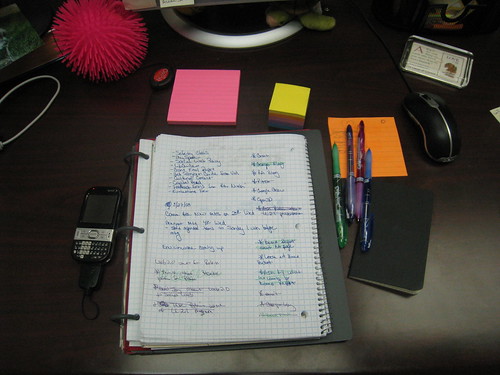 |
| By Librarian by Day |
As I’ve mentioned before, I’ve been talking about organization and thinking a lot about it too. I even went to Ravelry and asked some of the people in the Designers forum how they stay organized. I’ve been mining Pinterest, and even came across this great graphic.
I wanted to share some of what I’ve learned:
Over and over again I’ve heard that it doesn’t really matter what your system is, if it works for you. Just make sure you have some system. If you are designing as a career, treat it like one. Act professional. Stay organized so you can meet deadlines on time.
Every month I do a pattern update, making note of what’s in the docket, what has been turned in, and what has been published. Someday someone (probably me) will aggregate all this information and come to some conclusions someday.
Totem (working title) – Sock Pattern
Totem was kinda crazy – I had to do three socks in three weeks. It’s been turned in to Sockupied in Sep., and you should see the fruits of my efforts in the Spring Issue.
Totoro (working title) – Sock Pattern
Pattern turned into Three Irish Girls, and pattern tester has knitted it. Final draft turned in Sep. Should be published sometime in the Winter.
Isis Wings (working title) – Sock Pattern
Pattern turned into Three Irish Girls, and pattern tester has knitted it. Final draft turned in Sep. Should be published sometime in the Winter.
Crochet Top (working title) – Crochet Short Sleeved Pullover
Pattern turned into Classic Elite Yarns in August. Should be published in the Spring.
Crochet Meets in Middle (working title) – Crochet Pullover
All but last pattern done.
Proposals turned in this month: 2 (shameful – I had a lot going on this month though)
Classes Taught: none
Classes Coming Up: none
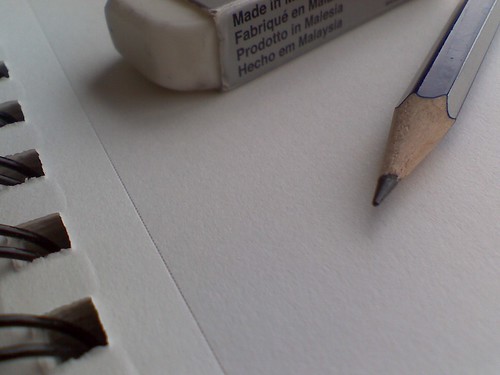 |
| Note : Image copyrights – © shawncampbell (Flickr) Source : shawncampbell (flickr) |
Changes have been made to the pattern page. Go take a look.
It’s been a while since I last talked about Michael’s Train Quilt, aside from an odd mention here or there. I’ve been in the process of machine quilting it, which turned out to be more of a project than I anticipated. I thought I was going to freeform quilt it, but it became very clear very early on that it wasn’t going to work well. So then, after much deliberation, I ended up basting it with spray-on basting, pinning it in places, and just running random lines across the quilt. It looked really bad when I first started. The more lines I get going across it, the better it is starting to look. I’m hoping I might get the quilting done this weekend.
 |
| By Lucy Knisley |
Then I can think about doing the binding, god help me.
The point is, I’m close. Very close.
And it got me thinking. While I don’t think I really like sewing or quilting as a hobby, and while there is a lot to learn from sewing a garment that can apply to knitting – I’m thinking about doing another quilt.
Bear with me. I’ve always really liked apple posters that show all the different varieties of apples. Like this, this or this. Then, earlier this week I saw a picture by Lucy Knisley, pictured at right.
Now let me say – I think the best art inspires you yourself. It might mean it creates some strong emotion in you, but it also might just mean that it speaks to you and inspires you yourself. This is what happened to me.
And I thought to myself, “That’s nice.” Then, “She got the Red Delicious wrong. And I prefer calling a Crispin and Mutzu. I can’t believe she didn’t include Pink Lady or Winesap or Johnathan.”
Which just shows you how much of an apple snob I am. But then I thought – I wish I could paint like that. I’d make a better poster. And then I realized that it’d make the perfect little/not so little quilt. I could take white or cream squares, draw out the apples. Color them with crayon, iron them, and then embroider on them. It’d be so cool. And then I could make it into a quilt.
So I’m thinking I gotta get my apple mojo going.
What apples would you have to include on an apple quilt?
I’ve been thinking a lot about making the most of my time and getting things done. It’s not a surprise, since the beginning of Fall is much more about new beginnings than the New Year’s ever is.
| the corkboard of doom, looking bare because it was just put together after the cats tore it up. |
One of my favorite authors, Seanan McGuire, describes herself as a pumpkin girl – a child of autumn as you will (her letters to the great pumpkin are worth reading). That resonates strongly with me – for there’s a whole lot of potential in the fall – school (the portal of learning) starting, seeds (which will grow into things) dropping, food ripening and being stored for winters, Halloween (where you can be ANYTHING your brain and creativity can come up with) – there’s so much stored energy in the Fall.
So it makes sense that I’d start looking at how I organize myself and my life. One of the best tools I use right now to organize my designing is a set of two cork-boards. They work like this: The first cork board has four categories: calls for proposal, pending proposals, submitted proposals and pending contracts. I try to keep at least two items in each of the first three categories, and hopefully at least one in the fourth.
Be the first to learn about classes, patterns. upcoming events and more.